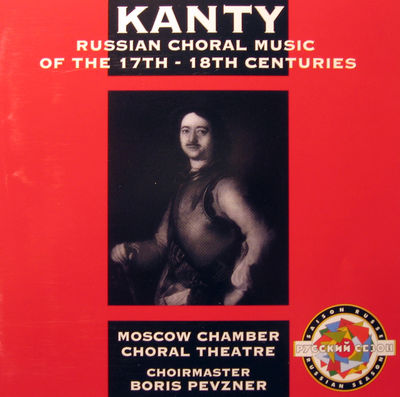
KANTY
17th and 18th century Russian choral music
The genre of the kanty in Russian music is mainly associated with the reign of Peter the Great (1689-1725), the period when Russia went through a transformation due to the intensive introduction of Western institutions, manners and customs, and when there was, among other things, a rapid secularization of culture. Within a few decades a separation took place between religious music, the only type of music officially recognized until that time (the popular music transmitted by the skomorokhi - minstrels and buffoons - being in bad repute and prohibited by the Church), and a secular repertory that became widely established in the life of the towns and cities.
And yet the kanty were originally a religious genre. Introduced into Russia via Poland in the second half of the 17th century, they experienced a development parallel to that of the « Partessian » chant, the great motets that were beginning to the admitted into the repertories of professionnal choirs at the time. But whereas Partessian singing was Italian in origin, the kanty were derived from the Lutheran chorale, with its distinctively square build, its simplicity and strophic form, although it was not long before Polish, Russian and Ukrainian melodic elements were integrated into them. They were generally sung in three parts, two superior melodic parts in parallel thirds and a harmonic bass part. A paraliturgical genre, they were settings of texts paraphrasing the Scriptures, or commentaries on Christian moral precepts. These literary texts, written by the authors of the period, lettered ecclesiastics like Simeon Polotsky, Stefan Yavorsky, Feofan Propokovitch, correspond to the beginnings of metric poetty in Russia as well as the first union of poetry and music. Several examples are to be found here. The composers are mostly anonymous, but under Peter the Great one name stands out, that of Vassili Titov (1650-1715), who became musician-in-ordinary to the Tsar.
The historical battles, the victories and the peace treaties that mark the history of Russia during those years quite naturally are reflected in the music. The kanty of the reign of Peter the Great became patriotic songs and panegyrics, their texts sometimes still bearing traces of a religious language, but becoming increasingly secular. Their musical characteristics were adapted to the circumstances, as well, with the melodies growing more martial, imitating trumpet-calls and strewn with "vivats". Two examples of this type are Rejoice, Peter and the Kant upon the conclusion of the Treaty of Nystad (the treaty of 1721 ending the Russo-Swedish war and ceding the Baltic teritories to Russia). These songs were generally performed out of doors, accompanied by fanfares, peals of bells, drum rolls, and sometimes even volleys of artillery. An example of a panegyric kant is Daughter of Peter the First composed for the coronation of the Tsarina Elizaveta Petrovna in 1742.
An urban style of life, and the rapid rise of a middle class in the new capital, Saint Petersburg, were conducive to the appearance and the diffusion of a semi-popular type of music. The last stage in the evolution of the kanty, from the beginning to the middle of the 18th century, was that of an urban folk music in which the three-part chorus was sometimes replaced by a soloist with an instrumental accompaniment. The playing of the flute, the harp and the harpsichord became more widespread and was soon very much in fashion. The character of the songs usually ranges from a delicate lyricism, an affected galanterie to a popular folk humour. The latter aspect is abundantly represented in drinking songs and ironical and satirical couplets of all kinds, such as the hilarious Song of the mushrooms, a setting of a well-know folk tale.
From the para-liturgical chorus to the patriotic paean and the entertaining song, the kanty would have been the musical reflections par excellence of the transition of Russia to a modern state. They gradually fell into disuse towards the end of the 18th century, ousted by the massive onslaught of Italian art. But the original religious aspect of the genre was kept alive by the communities of the Old Believers. It was to the melody of one of these archaic kanty that Mussorgsky was to write the final chorus of his Khovantchina.




